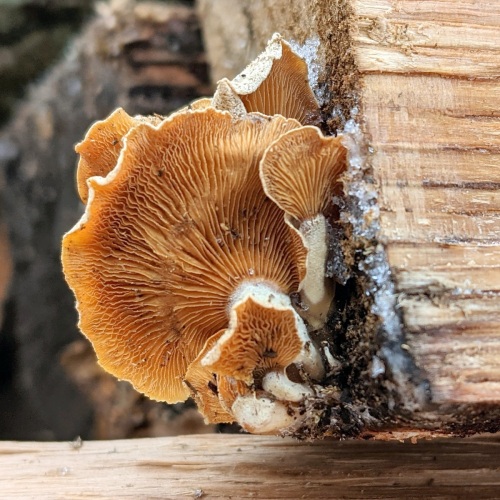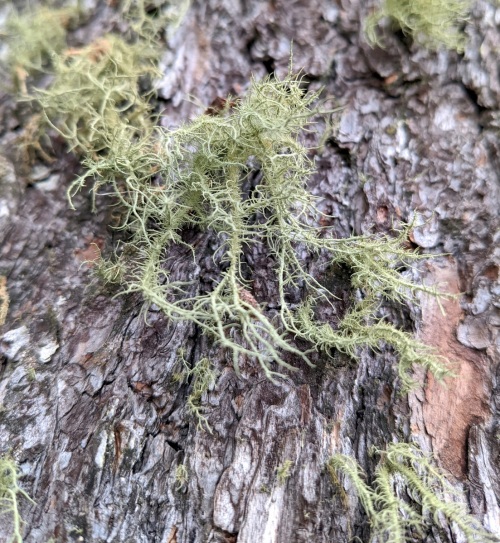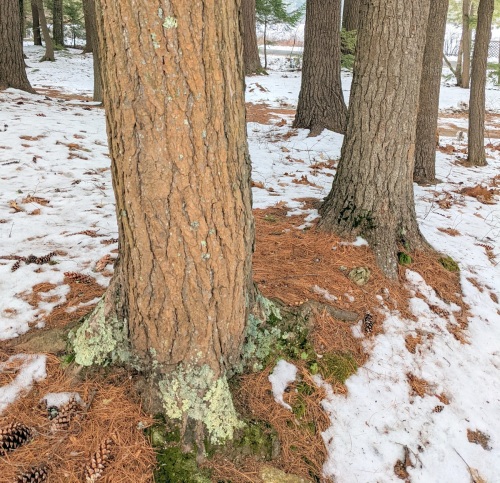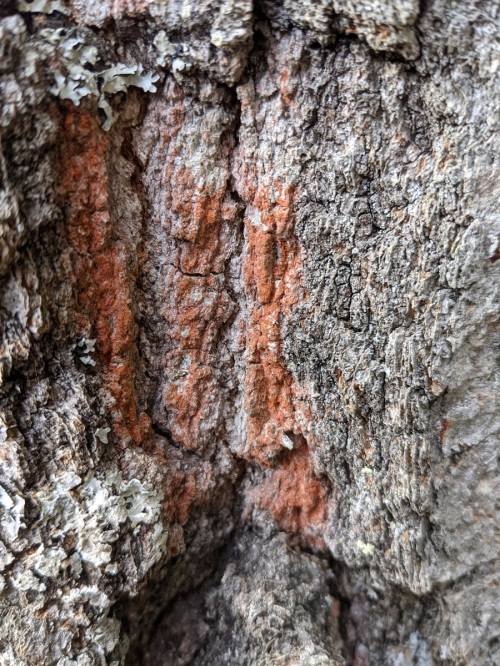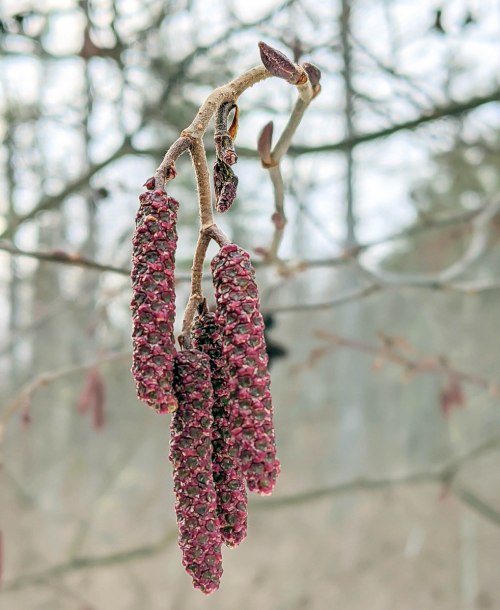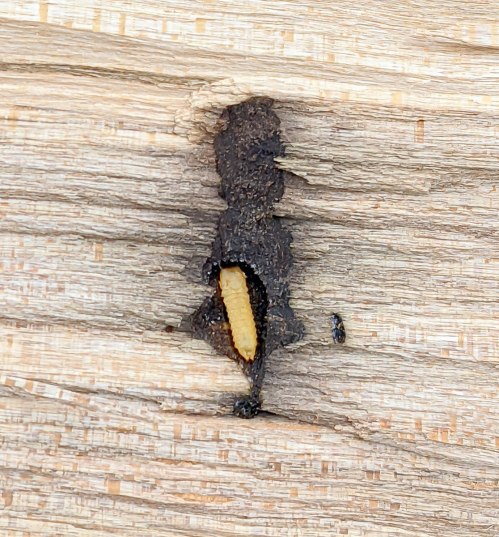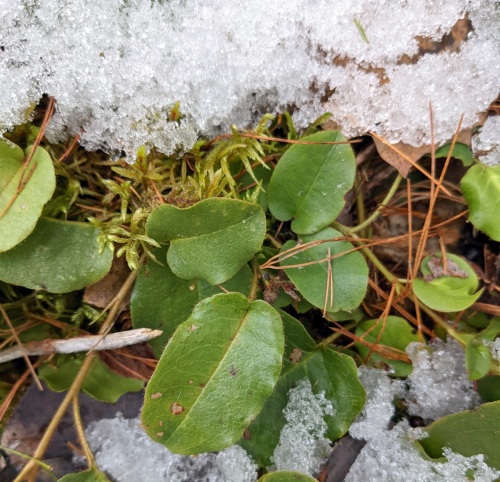I’ve seen some really stunning photos coming from smartphones lately so since it was time for me to get a new one I spent quite a lot of time researching which one had the best camera for the money. By the end of this post I hope you’ll agree that I made a good choice; the tiny mushroom in the photo above was hardly bigger than a pea. Yes this phone does macro photography, and it does it well.
Tiny bird’s nest fungi weren’t much of a challenge for the phone but depth of field was slightly off. I think that was my fault more than the phone’s though.
I was splitting wood at work and there, deep inside a piece of oak, was this mushroom mycelium. I was lucky I had a phone with me that could see it and get a half way decent photo of it. I always love finding mycelium because I never know what my imagination will have me see in it. You might see a river delta. Or a tree. Or bird feathers. Or you might see the vast one-ness from which all life arises. Whatever you see in it let it be beautiful; let it reflect the beauty that is inside you.
One of the haircap mosses, either mountain or juniper haircap moss I believe, peeked out from under a dome of paper thin ice. This is a male moss and you can tell that by its color and by the tiny male reproductive structures called antheridia, which look like tiny flowers scattered here and there.
And here was a female haircap moss with its spore capsules almost ready to release their spores. There was a breeze this day and the phone camera didn’t freeze the movement of the capsules as much as I would have hoped but something about this photo grabs me so I’ve added it here, slightly blurred capsules and all. It’s a mouse eye view of the landscape with a certain minimalistic Japanese feel to it, and maybe that’s why I like it.
This bristly beard lichen growing on a white pine is another photo where the depth of field was slightly off and I think it’s happening because I’m getting too close. In fact the phone has told me to “back up for better focus”. But I’ll learn; I’m used to taking photos with my Olympus macro camera, where I can be almost touching the subject. A bristly beard lichen has isidia, which appear as little bumps along its branches. An isidium is a reproductive structure common to some lichens and their presence is a good identifier.
This liverwort, called flat-leaved scalewort (Radula complanata) was about 3/4 of an inch across and grew on a tree, and I thought the phone handled it well. I’ve read that this liverwort is common on trees and shrubs but I rarely see it. Plants are usually flattened, either forming patches like the one seen above or single stems creeping among mosses. It has round, flattened, overlapping leaves which are quite small. Each one is no more than 1/16 of an inch across. This liverwort is said to like sunny, sheltered, moist conditions and will sometimes grow on streamside rocks. Liverworts are epiphytes that take nothing from the trees and shrubs they grow on. They simply perch on them, like birds.
Color reproduction seems to be quite accurate with this phone but beware that this is coming from one who is colorblind. Still, even someone colorblind can see the difference between the hemlock in the foreground and the one beside it, because the one in the foreground is “artificially” colored by Trentepohlia algae. I don’t think I’ve seen this much algae on a single tree before. I wonder how it chooses which trees to grow on and I wonder why, in this case, it hasn’t spread to other trees.
Here is a phone camera macro look at algae on a different tree.
Tiny lichens are a big part of the content on this blog so of course I had to see what the phone could do with them. Again, I think I was a bit too close to this one but I was impressed with the camera. This lichen was only about a half inch across.
In this photo I backed the phone away from the subject lichen and the shot came out much better. This lichen was about half the size of the previous one but it came out much sharper so I’ve got to watch out for getting too close.
Compared to the lichens these alder catkins were huge but the phone camera handled them well, even in a breeze.
I wanted to show something that everyone reading this would know the size of, so for that I chose lilac buds. This is an excellent example of what this phone can do.
The bud of a Norway maple is not something everyone will recognize but they are slightly smaller than the lilac buds.
If you’ve ever wondered why woodpeckers spend so much time drilling into trees, this is why. This yellow insect larva was deep inside a red oak log, seen only when I split it. The tiny creature was about the diameter of a piece of spaghetti and maybe an inch long.
This is just simple stream ice but it was beautiful, I thought.
Of course I had to try plants with the phone camera and it did well on this trailing arbutus. I didn’t want to kneel in the snow so I just bent down and clicked. This phone is said to use a kind of artificial intelligence chip that I don’t fully understand, and it said to be able to compute very fast. In fact I’ve read that some phones can do 5 trillion operations per second. Speed is one thing, but this phone seems to know or sense what you want before you tell it what you want and I find that a bit odd, if not unsettling. It’s almost like having an assistant who does all the work for you.
Here were the dried flower heads of sweet everlasting. There was a breeze on this day and once again the phone handled it well.
The color red is a challenge for any camera so I thought I’d try some holly berries. The phone camera once again did well, I thought. I like the detail that came through on the leaves as well.
Boston ivy berries (Parthenocissus tricuspidata) are about as big as a small pea, so while I was walking past them while going in for a haircut I thought I’d see what the phone could do with them. I was happy with the shot. Boston ivy isn’t a true ivy and it isn’t from Boston but it is pretty on buildings, especially in the fall when its leaves turn bright red. True ivy belongs to the genus Hedera but Boston ivy is the ivy that lends its name to ivy league universities.
The phone camera seems to do well on landscapes as well. It also has a “night vision mode” but I didn’t use it for this shot of a stream I pass on my way to work early each morning.
The phone tells me I was 11 meters (36 feet) from this tree when I took it’s photo. Why it thinks I need to know that is a mystery. I would have fumbled around with my camera settings for several minutes for this shot, trying to keep the trees light and the clouds dark, but the camera phone did it in two shots without my changing any settings.
This shot looking up a pine tree was taken in almost full darkness, well after sundown and with twilight almost gone. When you push the shutter button on the phone you can hear the shutter click twice when it’s in night vision mode and the photo comes out like this. How it does this is unknown to me as yet. I wanted to show you a dark sky full of bright stars but it has been cloudy every night since I bought the phone.
This shot, taken before sunup early in the morning, was the first shot I ever took with the new phone. I suppose I should give you the name of this phone after putting you through all of this, shouldn’t I? It’s a Google Pixel 4A, 5G and for the same money, according to the reviews I’ve read, no other phone camera can touch it. I find that it is especially useful in low light situations but I also find it a bit awkward to hold a phone while taking photos. I’m certainly happy with it but I think I need more practice. I’m guessing that when the newness wears off it will become just another tool in my tool kit; a camera I can speak into.
We become what we behold. We shape our tools and then our tools shape us.
~Marshall McLuhan
Thanks for coming by.
